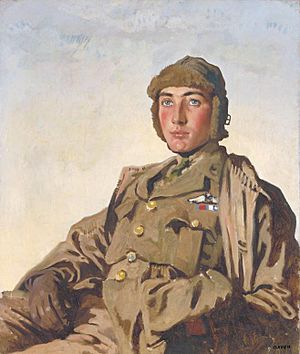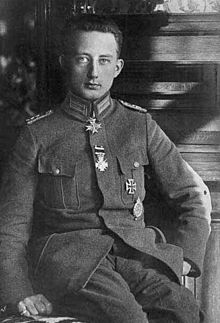Arthur Rhys-Davids facts for kids
Quick facts for kids
Arthur Rhys-Davids
|
|
|---|---|

Lieut. A. P. F. Rhys Davids, DSO, MC painted by William Orpen, October 1917
|
|
| Born | 26 September 1897 Forest Hill, London, England |
| Died | 27 October 1917 (aged 20) Roeselare, West Flanders, Belgium |
| Allegiance | United Kingdom |
| Service/ |
British Army |
| Years of service | 1916–1917 |
| Rank | Lieutenant |
| Unit | No. 56 Squadron RFC |
| Battles/wars | First World War |
| Awards | Distinguished Service Order Military Cross & Bar |
| Relations | Thomas Rhys-Davids (father) Caroline Rhys-Davids (mother) |
Arthur Percival Foley Rhys-Davids (born September 26, 1897 – died October 27, 1917) was a very skilled British pilot during the First World War. He was known as a "flying ace" because he shot down many enemy aircraft.
Rhys-Davids came from a smart and well-known family. His father was a professor, and his mother was a famous writer. This meant Arthur got a great education. He was excellent at all his school subjects. When he was 14, he went to Eton College, a famous school in England. He did so well that he earned a special scholarship.
When World War I started in 1914, Rhys-Davids decided to join the war effort. In mid-1916, he applied to become a pilot in the Royal Flying Corps. He started his training on August 28, 1916. After finishing his training in the spring of 1917, he joined No. 56 Squadron RFC on March 7, 1917.
Rhys-Davids got his first air victory on May 23, 1917. Just two days later, he shot down his fifth enemy plane, officially becoming a flying ace. He achieved most of his victories during the Third Battle of Ypres (July–November 1917). By the time he died, he had shot down 22 more planes. On September 23, Rhys-Davids famously shot down German ace Werner Voss, who had 48 victories. By October 11, 1917, Rhys-Davids had a total of 27 official air victories.
Rhys-Davids was known as a brave "fighter." He would chase enemy planes whenever he saw them. On October 27, 1917, he chased a group of German planes over Roeselare, Belgium. He was never seen again. Some experts believe he was shot down by German ace Karl Gallwitz. Even though he disappeared close to where Werner Voss crashed, his body was never found.
Early Life and Education
Arthur Rhys-Davids was born in Forest Hill, London. His parents were Thomas William Rhys Davids and Caroline Augusta Foley Rhys Davids. Both were very educated and spent a lot of time with their children.
His father, Thomas, was a professor who studied ancient languages like Sanskrit and Pali. He was also interested in Buddhism. His mother, Caroline, was a successful writer and scholar. She studied economics and Indian philosophy.
Arthur started kindergarten at age three. He later went to Doctor Summerfield's Preparatory School. In September 1910, he took exams for Eton College and won a special scholarship. This meant he was a "Colleger," a student chosen for his ability rather than his family's wealth.
At Eton, Arthur was very good at sports like football, cricket, and rugby, even though he had asthma. He was especially good at studying Classics (Ancient Greek and Latin). In July 1913, he achieved the highest marks in his class. By 1916, he was named Captain of the School. It was around this time that he first showed interest in becoming a pilot.
Becoming a Pilot
On August 28, 1916, Rhys-Davids began his flight training at Oxford. He didn't enjoy the strict army life at first. He was soon moved to the Central Flying School for more advanced training. One of his instructors, Keith Muspratt, became a good friend.
Rhys-Davids quickly learned to fly different planes like the Royal Aircraft Factory B.E.2 and Avro 504. By December 1916, he was flying on his own regularly. In January 1917, he started flying Sopwith Pups and even did a "loop" for the first time. After gunnery training, he was posted to No. 56 Squadron RFC on March 7, 1917. This squadron was famous and had top pilots like Albert Ball. They also had new, powerful S.E.5 planes. On April 7, 1917, Rhys-Davids left for France to join the war.
War Service
From Beginner to Ace
Rhys-Davids' start as a fighter pilot was a bit rough. He crashed his new SE5 plane during a landing, which grounded him for a month. His first combat mission was on May 3, 1917, escorting bombers.
On May 7, he was part of a difficult mission. His squadron ran into skilled German pilots from the "Flying Circus." Famous ace Albert Ball was killed, and Rhys-Davids's plane was hit by a German ace named Kurt Wolff. Rhys-Davids's guns jammed, but he managed to escape and land safely, even though his engine was badly damaged.
Despite these challenges, Rhys-Davids got his first victory on May 23, 1917. He shot down an Albatros D.III fighter. The very next day, he scored three more victories in just one hour. On May 25, he shot down another plane, becoming a flying ace with five victories. For his bravery, he was awarded the Military Cross (MC) on June 5, 1917.
In July, Rhys-Davids continued his success. He shot down a German reconnaissance plane and captured its crew. He followed this with more victories against Albatros planes. The start of the Third Ypres Campaign on July 31 gave him even more chances to fight. On September 5, he shot down two more planes and damaged another in just 45 minutes.
A Famous Dogfight
On September 23, Rhys-Davids was involved in one of the most famous air battles of the war. He was flying with his squadron when they saw a German fighter chasing a British plane. The German pilot was Werner Voss, a very skilled ace with 48 victories.
Rhys-Davids and five other British pilots attacked Voss. The German pilot was incredibly good, flying his plane wonderfully and firing at everyone at once. He hit several British planes, forcing some out of the fight. Voss made no attempt to escape, fighting bravely against six British planes.

The fight lasted for ten intense minutes. Voss kept dodging the British attacks. Finally, Rhys-Davids managed to get behind Voss's plane and fired. The German plane went down. Rhys-Davids fired again, and the plane crashed. Another British pilot, James McCudden, watched it happen and later said he had never seen such a brave German pilot.
After shooting down Voss, Rhys-Davids also damaged another German plane. When he returned to base, everyone was talking about the amazing fight. The Germans soon announced that Werner Voss was missing. Rhys-Davids received many congratulations, but he felt sad, wishing he could have captured Voss alive.
Final Flight
In the next three weeks, Rhys-Davids achieved five more victories. His last one was on October 11, 1917. On October 1, he was awarded the Distinguished Service Order for his outstanding bravery. The award recognized him for shooting down nine enemy aircraft in nine weeks. He was described as a "magnificent fighter" who always attacked, no matter how many enemies he faced.
His final count was 27 enemy aircraft shot down. His commanding officer, James McCudden, greatly admired his fighting spirit. He said that if you saw a British plane fighting many German planes, it was usually Rhys-Davids.
On October 27, 1917, Rhys-Davids was promoted to lieutenant. That same day, he took off on a patrol and was last seen chasing German planes. The German Air Service later said that Karl Gallwitz shot him down. It wasn't until December 29, 1917, that the British received a note from the Germans confirming Rhys-Davids's death.
Arthur Rhys-Davids has no known grave. His name is carved on the Air Services Memorial in Arras, France, honoring pilots who died without a known burial place.
See Also
- List of people who disappeared
List of Victories
| Victory No. | Date | Location | Kills | Notes |
|---|---|---|---|---|
| 1. | 23 May 1917 | East of Lens | Albatros D.III | Out of control |
| 2–4. | 24 May 1917 | South of Doui/Gouy-sous-Bellone/Sains. | Three Single-seaters | Out of control First shared with B Flight. |
| 5. | 25 May 1917 | Lens | Two-seater | Destroyed |
| 6. | 26 May 1917 | Gouy-sous-Bellone | Albatros D.III | Out of control. |
| 7. | 4 June 1917 | West of Moorslede. | Albatros D.III | Destroyed. |
| 8. | 7 June 1917 | Westroosebeke | Albatros D.III | Out of control |
| 9–10. | 12 July 1917 | Brickfield/East of Roncq | DFW C.V and Fokker D.V | Forced to land/out of control. First victory DFW CV 799/17.Fl/Abt.7 Leutnant Mann and Unteroffizier Hahnel prisoner of war. |
| 11. | 13 July 1917 | Menin | Albatros D.III | Out of control. |
| 12. | 17 July 1917 | Menin | Albatros D.III | Out of control. Shared with B Flight. |
| 13. | 21 July 1917 | Polygon Wood | Albatros D.III | Out of control. |
| 14. | 3 September 1917 | Houthem | Albatros D.III | Destroyed. Shared with Maybery. |
| 15–17. | 5 September 1917 | East of Menin/East of Menin/Poelcapelle | Three Albatros D.III | Out of control/Two destroyed. One possibly Alfred Muth from Jasta 27. |
| 18–19. | 9 September 1917 | Houthulst Forest/Moorslede | Two Albatros D.III | Destroyed/driven down. |
| 20. | 14 September 1917 | Menin | Albatros D.III | Out of control. Possibly a Leutnant Gross from Jasta 10. |
| 21–22. | 23 September 1917 | Both North-East of Ypres Salient | Fokker Dr.I/Albatros D.III | Destroyed/Forced to land. Werner Voss (Jasta 10), killed in action; and possibly Carl Menckhoff (Jasta 3), crash-landed. |
| 23. | 24 September 1917 | Houthulst Forest | Two seater | Destroyed in Flames. The Machine, from Fliegerabteilung 256, crashed killing Carl von Esmarch and Hans Fleischer. |
| 24. | 28 September 1917 | Comines | Albatros D.III | Out of control. |
| 25–26. | 1 October 1917 | Westroosebeke | Two Albatros D.III | Both Out of control. Shared first with B Flight |
| 27. | 11 October 1917 | Beceleare | Albatros D.III | Out of control. |
Images for kids


